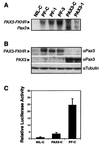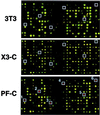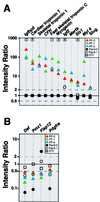cDNA microarrays detect activation of a myogenic transcription program by the PAX3-FKHR fusion oncogene
- PMID: 10557309
- PMCID: PMC23936
- DOI: 10.1073/pnas.96.23.13264
cDNA microarrays detect activation of a myogenic transcription program by the PAX3-FKHR fusion oncogene
Abstract
Alveolar rhabdomyosarcoma is an aggressive pediatric cancer of striated muscle characterized in 60% of cases by a t(2;13)(q35;q14). This results in the fusion of PAX3, a developmental transcription factor required for limb myogenesis, with FKHR, a member of the forkhead family of transcription factors. The resultant PAX3-FKHR gene possesses transforming properties; however, the effects of this chimeric oncogene on gene expression are largely unknown. To investigate the actions of these transcription factors, both Pax3 and PAX3-FKHR were introduced into NIH 3T3 cells, and the resultant gene expression changes were analyzed with a murine cDNA microarray containing 2,225 elements. We found that PAX3-FKHR but not PAX3 activated a myogenic transcription program including the induction of transcription factors MyoD, Myogenin, Six1, and Slug as well as a battery of genes involved in several aspects of muscle function. Notable among this group were the growth factor gene Igf2 and its binding protein Igfbp5. Relevance of this model was suggested by verification that three of these genes (IGFBP5, HSIX1, and Slug) were also expressed in alveolar rhabdomyosarcoma cell lines. This study utilizes cDNA microarrays to elucidate the pattern of gene expression induced by an oncogenic transcription factor and demonstrates the profound myogenic properties of PAX3-FKHR in NIH 3T3 cells.
Figures




References
-
- Barr F G. Nat Genet. 1998;19:121–124. - PubMed
-
- Galili N, Davis R J, Fredericks W J, Mukhopadhyay S, Rauscher F J, III, Emanuel B S, Rovera G, Barr F G. Nat Genet. 1993;5:230–235. - PubMed
-
- Shapiro D N, Sublett J E, Li B, Downing J R, Naeve C W. Cancer Res. 1993;53:5108–5112. - PubMed
-
- Bennicelli J L, Fredericks W J, Wilson R B, Rauscher F J, III, Barr F G. Oncogene. 1995;11:119–130. - PubMed
MeSH terms
Substances
LinkOut - more resources
Full Text Sources
Other Literature Sources
Research Materials
Miscellaneous

